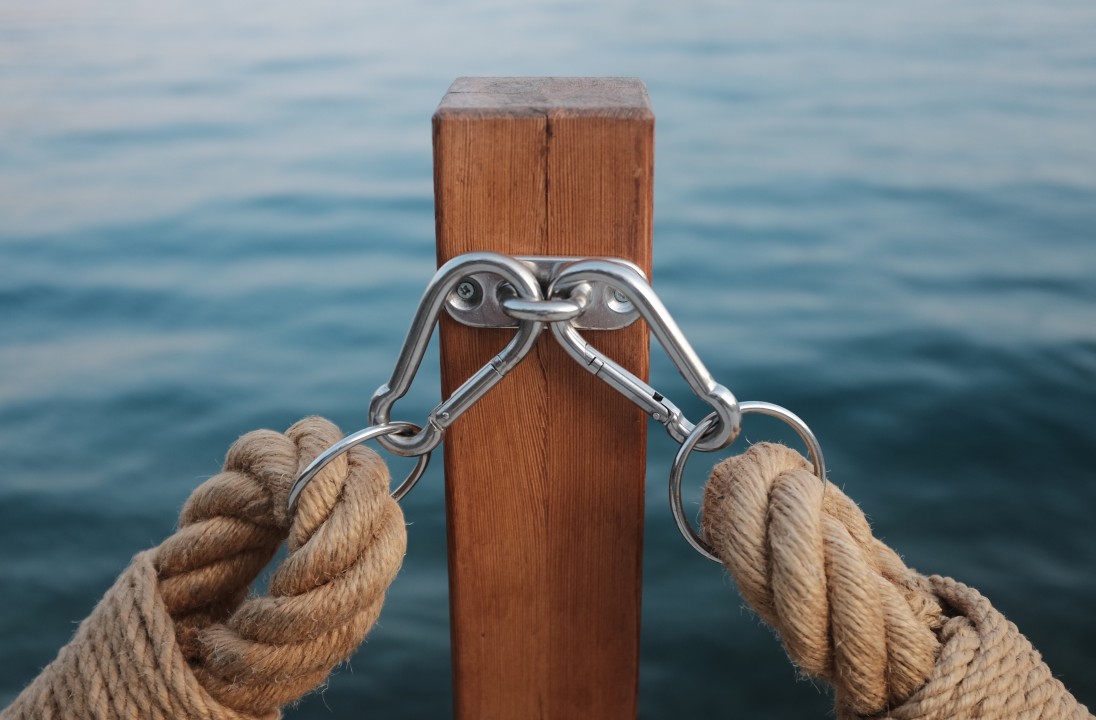Managing Project Interdependencies
Managing project dependencies (or interdependencies) is an often-missed tactical capability of project portfolio management (PPM). Yet, managing project dependencies is an important part of portfolio planning so as to tactically coordinate project execution. Successful management of project dependencies can reduce the risk of delayed projects, friction between projects, and the duplication of effort.
In our article on portfolio planning, we briefly covered that in order to optimize project execution we need the right sequence of projects. In order to properly sequence the projects in the portfolio we must understand whether there are any relationships between projects that would require some work to be completed before starting other project work. Since unknown interdependencies also represent a major portfolio risk, they need to be properly managed. In this article, we are going to cover the different types of dependencies, the importance of tracking project dependencies, how to effectively manage project dependencies, and how to conduct impact analysis.
For the remainder of the article, we will use the term “project interdependencies” more broadly to denote the relationships between projects. Some experts use the term “project interdependencies” only if two projects mutually impact one another. Certainly, there are cases where two projects affect each other, but more commonly one project impacts another project, and for that reason we will use the term “project interdependency” for understanding relationships between projects. The term “project dependency” is often used to denote task dependencies within a project (e.g. Finish to Start, Start to Start, Finish to Finish, etc.). This understanding is still useful, but we are focused on project relationships (not task relationships) and understanding the delivery impact that one project could have on another project.
What are the Types of Project Interdependencies?
There are several types of project interdependencies that Portfolio Managers and PMO’s need to know.
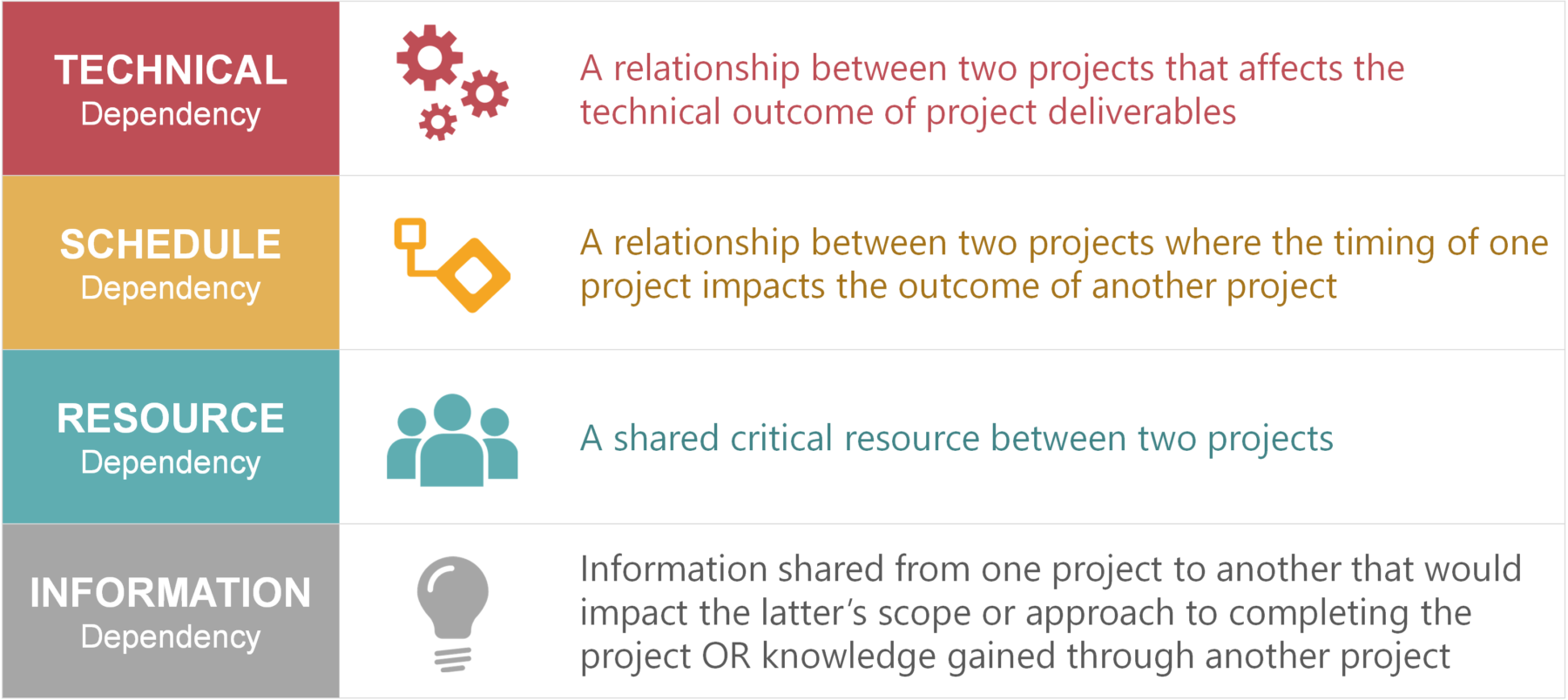
- Technical dependency: “a relationship between two projects that affects the technical outcome of project deliverables”. A technical dependency exists when one project cannot move forward (easily) without a deliverable from another project. This is similar to a finish-to-start relationship common in project schedules, except that it exists between projects. Example: in the IT environment projects may need certain infrastructure to be in place before a new solution can be released. If another project is responsible for setting up the new infrastructure, then there is a hard technical dependency between the two projects. Having multiple dependencies of this type only compounds the problem and quickly increases the complexity of completing the project on time, within scope, and within budget. It is very important for Project Managers to understand and document all of the technical dependencies to other projects.
- Schedule dependency (sometimes referred to as a synchronization dependency): “a relationship between two projects where the timing of one project impacts the outcome of another project”. A schedule dependency occurs when project deliverables are needed at the same time in order for both projects to finish. An IT example would be where one project is responsible for decommissioning a legacy system and storing the data in a data warehouse. Another project is responsible for implementing a new system that replaces the legacy system. The first project can fulfill the scope of work to retire the legacy system apart from having the new system implemented, and likewise the new system can be implemented whether or not the legacy system is retired, but there is a schedule relationship where the legacy system should not be retired until the new system is in place. In this case, there is a schedule relationship similar to a finish-to-finish relationship common in project schedules.
- Resource dependency: “a shared critical resource between two projects”. A resource dependency exists when critical resources are shared between projects. This dependency type is often managed at the portfolio level and resource manager level, but project teams should be aware of shared critical resources (e.g. Subject Matter Experts). If one project is off track and needs additional unplanned effort from critical resources, other projects may be impacted as well.
- Information dependency: this is a less critical relationship, but is worth noting so that important information is communicated to the impacted projects in a timely way. There are two aspects of an information dependency:
- Information shared from one project to another that would impact the latter’s scope or approach to completing the project. An informational dependency commonly exists when there is a known touch point between two projects and is based on changes to engineering standards, operational procedures, architecture, security, etc. For example, one project is working on changes to certain standards and procedures that affects another project. The upstream project team may not yet know what the final deliverable or solution is, but a downstream project knows that the results may impact its project’s design. There may not be a hard deliverable as described above, but changes to standards and procedures could create future re-work, so both project teams need to stay in close communication.
- The need to incorporate the capabilities and knowledge gained through another project. In this instance, important information gained from one project team should be passed on to another project team. This may occur more often in engineering and product development environments.
In addition to the various dependency types, it is also important to denote the level of impact for each dependency. This is similar to project risk management where the level of impact varies from risk to risk. Impact could be measured in terms of schedule delays, scope impacts, and cost. Mature organizations may use more sophisticated methods of measuring impact, but most organizations can utilize a simple high, medium, low scoring to denote levels of interdependency impact.

Why Managing Project Interdependencies Is Important
Unknown interdependencies represent a major portfolio risk and in complex environments, inadequate identification of project dependencies can derail projects or programs. Dependencies can be any deliverable, process, standard, technology, or product that is produced by one project team (or work group) but impacts another project or program. Projects that impact other projects may be referred to as upstream projects, predecessors, or givers. Projects that are impacted by other projects may be referred to as downstream projects, successors, or receivers.
Senior leadership needs to manage and monitor project dependencies within the portfolio. If left unmanaged, there could be deadly hidden costs of unnecessary workarounds, and the negative impact of such dependencies can severely affect schedule, scope, and cost. Schedule slides will be the most common impact when project teams have a technical dependency with another project and need certain deliverables to fulfill the scope of the project, but higher project costs can be incurred when projects are delayed or reworked due to scope changes. When a downstream project is impacted by an upstream project, the dependent project may still be able to move forward with reduced scope or an expensive scope change required to accommodate a work around as a result of the interdependency. We have seen expensive work-arounds implemented as temporary (i.e. “throw away”) solutions that would not have been developed had the upstream deliverables been ready on time.
Proactive management of project interdependencies can significantly reduce these risks and expenses. During the Work Intake process, Senior Leaders should ask the right questions such as “what is the real impact to this project if upstream project deliverables are not ready in time?” Will it impact the schedule by a week? By a month? Or longer?” “Are workarounds available if upstream project deliverables are not ready in time?” “If yes, what is the cost of the workaround?”
Thorough investigation and planning are needed in order to mitigate against these risks. Good portfolio planning will give decision makers the information they need to launch the right projects at the right time and sequence the work in the right order to minimize schedule delays, scope change, and budget increases. When it makes sense, a Program Manager may be needed to oversee the execution of related projects and help manage interdependencies between multiple projects. Furthermore, without understanding the relationships between projects, senior management may make a decision regarding one project without understanding the downstream repercussions to interdependent projects. Having this information will also help decision makers make better decisions about in-flight projects. Understanding the impacts of one project on another project is very important, but may be missed unless interdependencies are actively tracked and managed.
A Process for Managing Project Interdependencies
Managing project interdependencies is an iterative process. The more complex the organization, the more interdependencies will occur between projects, and more effort will be required to manage the interdependencies. In order to successfully establish the process for managing dependencies some preliminary questions need to be answered:
What data needs to be captured? (DATA)
The amount of data collected will vary from company to company and will be based on the maturity of the organization collecting the data. Lower maturity organizations may simply want to know that an interdependency exists and not go any deeper. More mature organizations may go further to understand the type and severity of the dependency as well as workarounds, cost of workarounds, timing, etc.
Who is going to capture it? (PEOPLE)
A Project Management Office (PMO) or Portfolio Manager should take the lead to define the process for identifying project interdependencies and the data required. The timing, quality, and amount of data collected will help determine who is responsible for the data. In the early phases of a project, a Business Analyst may be very capable of collecting all of the necessary data. However, if technical information and costs are needed, a Technical Analyst, Enterprise Architect and/or Solution Architect may need to be involved. If interdependency information is not used until later in the project lifecycle, a Project Manager may be the right person to collect and manage this data. Getting the right people involved at the right time is a critical success factor of proactively managing project interdependencies. In the future, we believe Artificial Intelligence and Machine Learning will help identify project dependencies.
How and When will it be captured? (PROCESS)
These questions relate to the process of collecting project interdependency data. The right people need to be involved, but they also need to understand the process for collecting data so that Senior Leaders consistently have the right information at the right time for making better decisions. The process may require face to face meetings at the initiation of a project, or it may be written in as part of a business case based on data gleaned from an existing system. The quantity and quality of the data may change during the project lifecycle.
Where will the data be stored? (TOOL)
Managing interdependency data should be captured in PPM software as this will reduce maintenance costs, increase visibility, improve quality, and raise the likelihood that the data will be available when needed. However, data may be stored in various systems or tools at different times in the project lifecycle. For instance, at project initiation, the initiator may only have limited data available and enter this information into the project proposal form. Perhaps at the next phase, it is entered into a dependency matrix for further analysis, but entered into a central IT system for general consumption.
Although the interdependency data will be stored in a system, technology alone will not identify all interdependencies. Some ongoing form of meetings will be required to discuss project dependencies, and face to face communication is the best form of communication to accomplish this. In the portfolio planning phase, Subject Matter Experts, Enterprise Architects, Senior Business Analysts, or Solution Architects, may be needed to do preliminary analysis to identify potential interdependencies. Once a project has been approved, a Project Manager and/or Program Manager will be responsible for ongoing management of the dependencies.
Recommended Process Steps:
1) Identify potential dependencies—a matrix of all active and potential projects should be created to help capture the initial dependency data. If the matrix is too large, then grouping projects into smaller portfolios will help make the matrix more manageable. Interdependency identification should begin with active projects in the portfolio. The initial exercise to identify interdependencies should happen with all of the Project Managers to be able to raise questions and discuss potential dependencies. In this initial meeting, document any potential dependencies and ask the Project Managers to schedule time to discuss details with the other Project Managers.
PRO TIP: share the project charter, business case or 1-pager to everyone in advance to ensure that a basic understanding of all the projects being discussed.
Start by sharing the concept of managing project interdependencies and begin to use common terminology. Terms such as Upstream/Downstream project can be useful. In the image below, the notion of Giver/Receiver can be helpful as well. An article from the Project Management Institute highlighted that projects that are impacting other projects are offering “contributions” where as projects on the receiving end have a dependency to those projects.
2) Identify project interdependency types—initial identification of dependencies is good, but further analysis is required to understand the specific type of project interdependency. When initiating dependency analysis, Project Managers of the active projects should be able to correctly identify dependency types. Later, when this process is expanded to Work Intake, Subject Matter Experts, Senior Business Analysts, or Solution Architects should get involved to understand and identify interdependencies for requested projects (proposals).
3) Impact assessment—merely knowing the types of project interdependencies between projects is necessary, but not sufficient. Project Leaders need to assess the level of impact in order to help the PMO, Portfolio Manager, and Program Manager (if applicable) to sequence projects appropriately. Projects that have numerous upstream dependencies have a much higher risk, whereas projects that affect multiple downstream projects will probably have a higher priority (thus receiving more resources and more attention) so as not to disrupt the downstream projects. For steps 1-3 see the matrix below for one way of capturing project interdependencies.
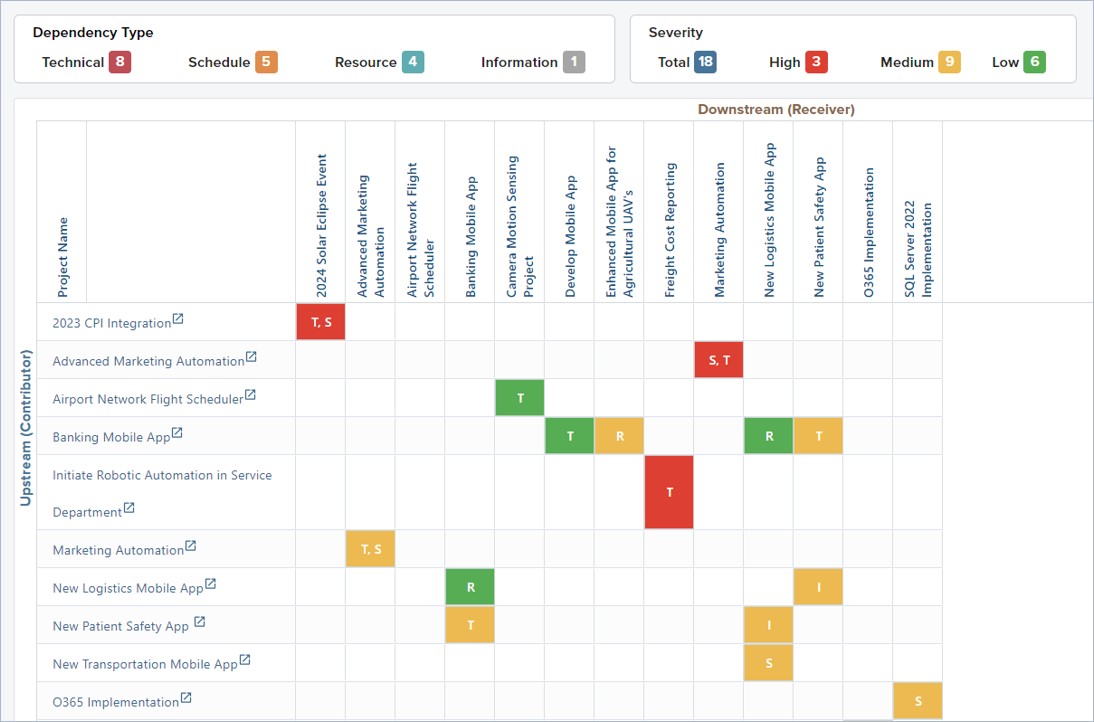
4) Get clarity and negotiate the dependency—Project teams must fully understand the details of the interdependency in order to take action. Negotiation is an important part of the process and requires strong project leadership because one side may not agree that a true dependency exists. Be sure to come to an agreement on the details of the dependency so that both sides can take appropriate action to manage the relationship and protect project delivery.
5) Build the project interdependency into the project plan—this makes all of the previous steps actionable and allows the project teams to monitor the status of the interdependencies. In some instances, Project Managers may put this information into the project schedule. Others may track the interdependencies through a risk management log or other reporting vehicle. Very mature organizations may build a hard dependency (i.e. finish-to-start task dependency) into the project schedule between projects so that if the upstream project slides, the downstream project’s schedule will reflect the schedule slide (NOTE: we do not generally recommend this approach, so proceed with caution).
For projects that heavily impact several other projects or are greatly impacted by several projects, an interdependency summary view can be created to depict the relationships between projects. This type of visualization can help the Portfolio Management Team and PMO make better decisions during governance meetings. In the example below, we can quickly see all of the projects impacting and being impacted by a given project along with the type of dependency between projects. Other key information such as stakeholders, affected systems and processes, and current priority ranking can be included to further enhance decision making.
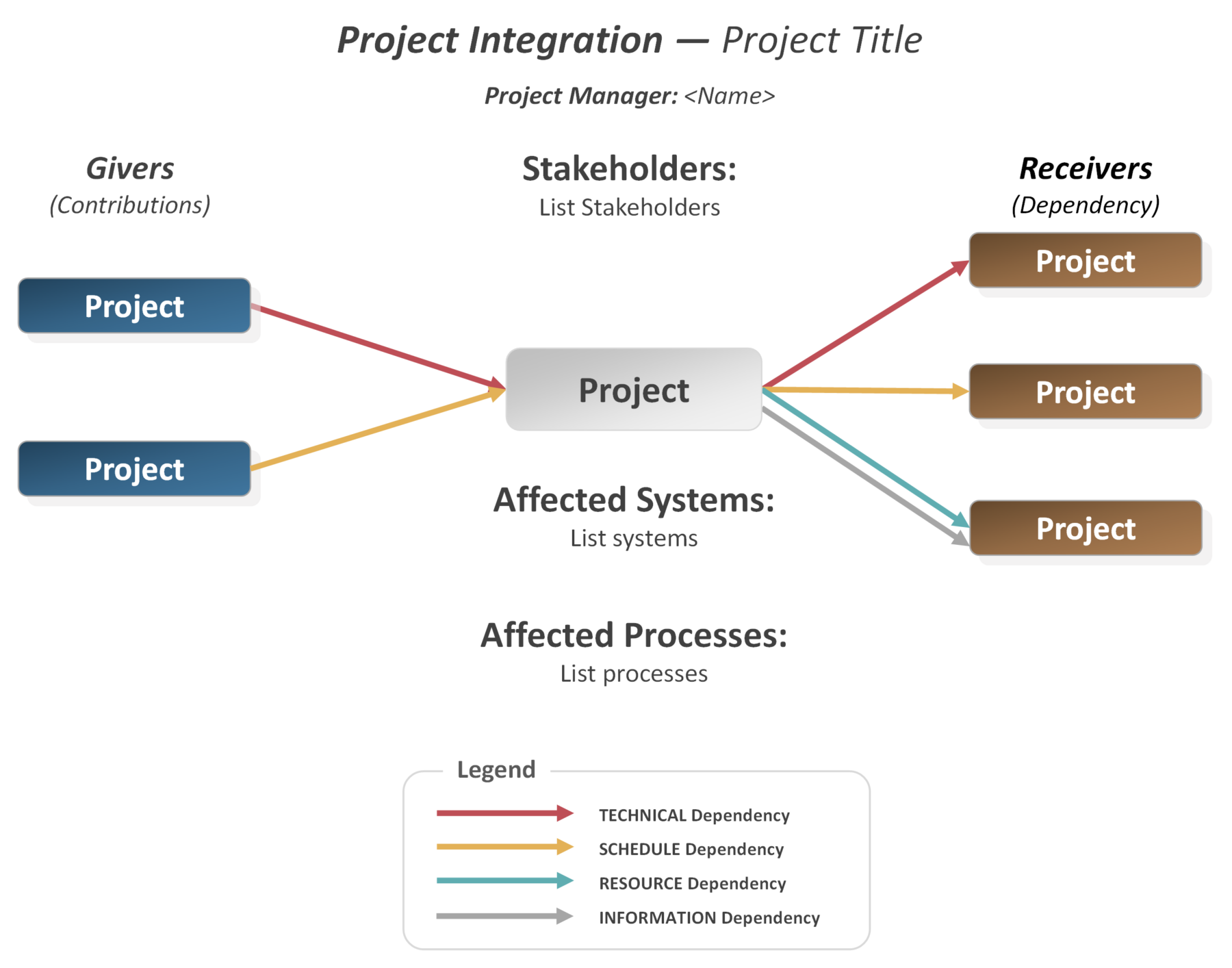
Portfolio Level Interdependency Impact Analysis
At a tactical level, Portfolio Managers can utilize dependency data in order to sequence projects in support of portfolio planning. But Portfolio Managers can also do further analysis in relation to portfolio risk management. A small number of projects may have a high degree of impact on other projects in the portfolio. Such projects could inflict a high degree of harm to the project portfolio and represent a major portfolio risk. Other projects are heavily impacted by multiple projects in the portfolio and these projects need a higher degree of risk management in order to successfully deliver the project. Both of these scenarios require impact analysis. We can use the same matrix we saw earlier to conduct some of this analysis.

We can count the number of project impacts by severity level for every project. This type of analysis will highlight which projects are ‘driver’ projects and which ones are most impacted. In the example below Project 10 impacts eight different projects (five medium impacts and three high impacts); most of these are resource impacts (“R”) but two are high impact technical dependencies (“T”). While this project has fewer total project impacts compared to Project 13 which has fourteen low impact informational dependencies, Project 10 has far more overall impact to other projects in the portfolio. The PMO and governance team will want to make sure that project 10 stays on track so as not to negatively affect other projects.
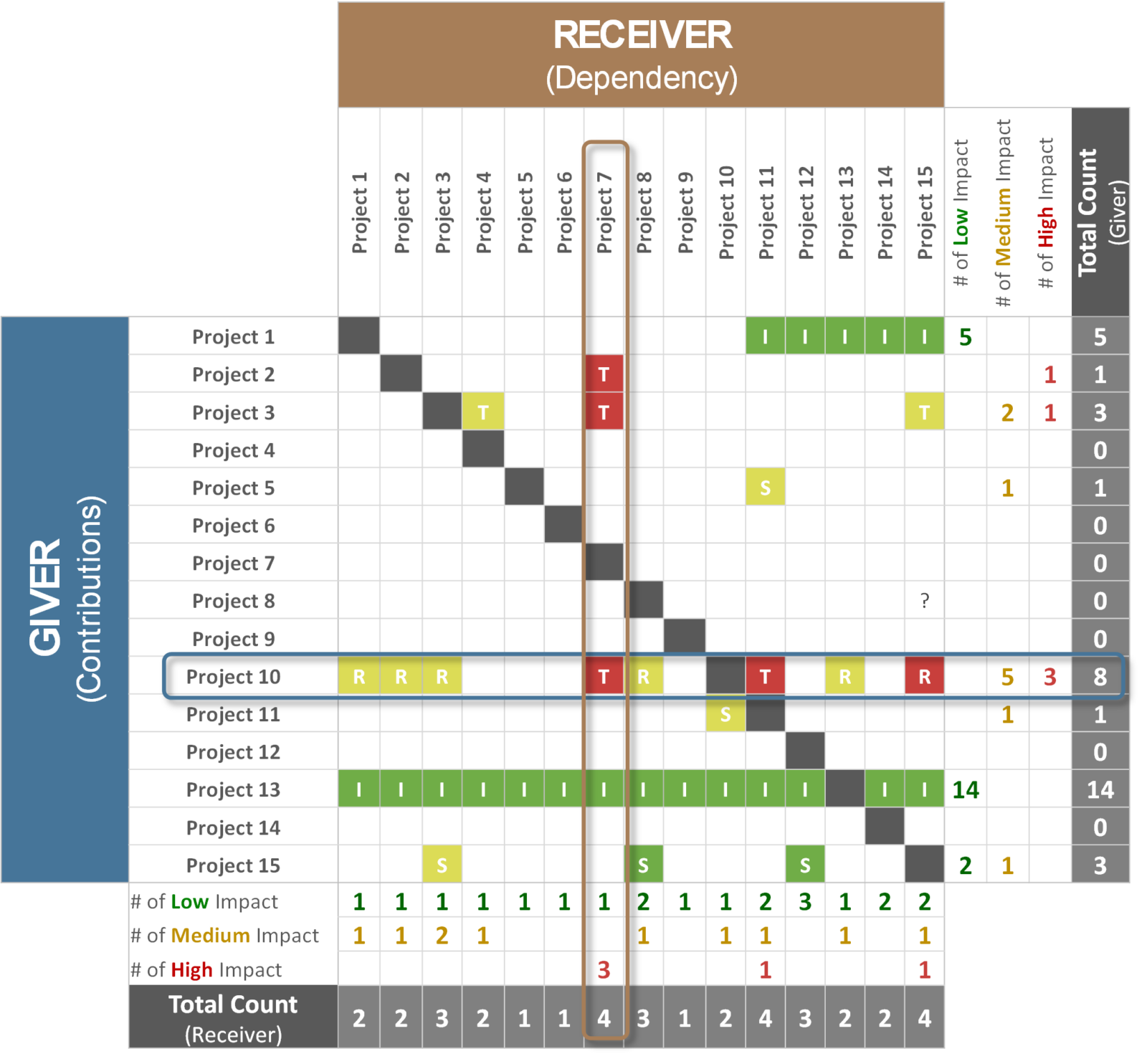
Furthermore, Project 7 has the most high impact interdependencies, all of which are technical dependencies. These impacts represent project risks that should be monitored by the Project Sponsor and portfolio governance team in order to help protect the delivery of this project. The PMO or Portfolio Manager should conduct this analysis and share it with both the portfolio management team as well as the team of Project and Program Managers to make them aware of such impacts and hold them accountable for managing such risks.
Summary
Managing project dependencies is an important component to successful portfolio planning. Proactive management of project dependencies will not only help ensure you have a successful portfolio, but also mitigates against some portfolio risks. A strong PMO will have ongoing discussions among Project and Program Managers to manage dependencies, but senior leadership should have a clear understanding of the key relationships among projects when making a number of portfolio related decisions.
Tim is a project and portfolio management consultant with over 15 years of experience working with the Fortune 500. He is an expert in maturity-based PPM and helps PMO Leaders build and improve their PMO to unlock more value for their company. He is one of the original PfMP’s (Portfolio Management Professionals) and a public speaker at business conferences and PMI events.
Technical dependency (a relationship between two projects that affects the technical outcome of project deliverables), Schedule dependency (a relationship between two projects where the timing of one project impacts the outcome of another project). Resource dependency (a shared critical resource between two projects), Information dependency (important information is communicated to the impacted projects in a timely way that could affect scope or quality). What are the four types of project interdependencies?

What is the high level process for identifying and managing project interdependencies?
Never miss an Acuity PPM article
Don't take our word, listen to what others are saying:
"I find value in all of your articles."
"Your articles are interesting and I am sharing them with my team who have limited project knowledge. They are very useful."


